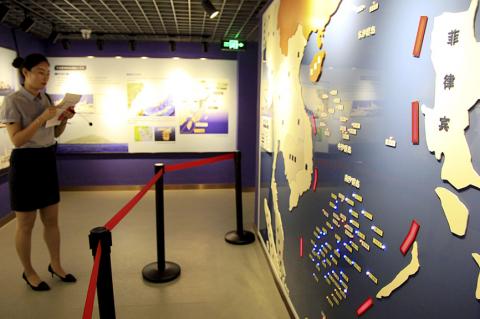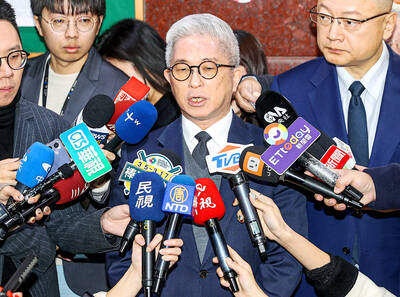President Tsai Ing-wen’s (蔡英文) administration has reached an internal resolution on Taiwan’s territorial claims over the South China Sea, which stresses the nation’s sovereignty over islands in the area, but makes no mention of the so-called “U-shaped line” and “historical waters,” a Presidential Office source said yesterday.
The government wants to differentiate Taiwan’s claims from China’s and avoid the impression that Taipei and Beijing have a unified stance on the issue, said the source, who asked not to be identified.
The U-shaped line — also known as the “11-dash line” — was featured in the “Location Map of the South China Sea Islands” drawn up by the Republic of China (ROC) government in 1947. After the Chinese Nationalist Party (KMT) lost the Chinese Civil War and fled to Taiwan, the Chinese Communist Party changed it to a “nine-dash line.”

Photo: Chinatopix via AP
After the Permanent Court of Arbitration in The Hague, Netherlands, on Tuesday ruled that Beijing’s claims of historical rights over the area based on its nine-dash line were invalid, the Ministry of the Interior and the Mainland Affairs Council issued statements stressing the ROC’s sovereignty over the South China Sea islands.
However, neither statement mentioned the U-shaped line or historical waters, although both referred to the map. That sparked speculation that the government has dropped the U-shaped line claim.
The source said the government’s position is clear: The ROC has sovereignty over South China Sea islands, including Itu Aba Island (Taiping Island, 太平島), and there is no need to mention the U-shaped line or historical waters to assert that position.
Another source said that when the map was drawn in 1947, it only marked the names and locations of the South China Sea islands and 11 demarcation lines, but terms like the “U-shaped line” or “11-dash line” did not exist then.
The demarcation lines were later referred to as the “11-dash line,” and after China proposed the “nine-dash line,” academics created the term U-shaped line to stress the similarity between Taiwan’s and China’s claims.
The term, like the so-called “1992 consensus,” was created and fashioned in retrospect, the source said.
A report by the US Department of State mapped the nine-dash line and 11-dash line and found that they represented different coordinates, suggesting they were different demarcation lines, the source said.
The Presidential Office source questioned the nature of the 11 demarcation lines on the map, saying there are no clear definitions on whether they represent national boundaries, island demarcation lines or historical territorial waters.
Neither the 11-dash line nor the U-shaped line is official terminology or a legal term, the source said.
When asked whether the Tsai administration has made it a policy not to mention the U-shaped line, Presidential Office spokesman Alex Huang (黃重諺) did not give a direct response at a routine news conference yesterday afternoon.
“The ROC government stands firm on its claim of sovereignty over islands in the South China Sea and their relevant waters, which are rightfully our rights in accordance with international law,” Huang said.
Huang said that all relevant documents, including those dating back to 1947, when the ROC government drew the map, show that the official name used is “islands in the South China Sea (南海諸島).”
Additional reporting by Stacy Hsu

Conflict with Taiwan could leave China with “massive economic disruption, catastrophic military losses, significant social unrest, and devastating sanctions,” a US think tank said in a report released on Monday. The German Marshall Fund released a report titled If China Attacks Taiwan: The Consequences for China of “Minor Conflict” and “Major War” Scenarios. The report details the “massive” economic, military, social and international costs to China in the event of a minor conflict or major war with Taiwan, estimating that the Chinese People’s Liberation Army (PLA) could sustain losses of more than half of its active-duty ground forces, including 100,000 troops. Understanding Chinese

AGING: As of last month, people aged 65 or older accounted for 20.06 percent of the total population and the number of couples who got married fell by 18,685 from 2024 Taiwan has surpassed South Korea as the country least willing to have children, with an annual crude birthrate of 4.62 per 1,000 people, Ministry of the Interior data showed yesterday. The nation was previously ranked the second-lowest country in terms of total fertility rate, or the average number of children a woman has in her lifetime. However, South Korea’s fertility rate began to recover from 2023, with total fertility rate rising from 0.72 and estimated to reach 0.82 to 0.85 by last year, and the crude birthrate projected at 6.7 per 1,000 people. Japan’s crude birthrate was projected to fall below six,

WARNING: If the defense budget is not approved by the legislature, systems such as the Harpoon missile coastal defense system would be impacted, Hsu Szu-chien said The armed forces have response protocols for a wide range of sudden contingencies, including the “Wan Chun Plan” to protect the head of state, the Ministry of National Defense said yesterday. After US President Donald Trump on Saturday launched a series of airstrikes in Venezuela and kidnapped deposed Venezuelan president Nicolas Maduro, concerns have been raised as to whether China would launch a similar “decapitation strike” on Taiwan. The armed forces regularly coordinate with government agencies and practice drills to ensure preparedness for a wide range of scenarios, Vice Minister of National Defense Hsu Szu-chien (徐斯儉) told reporters before a meeting at

Russia sent a submarine to escort an empty oil tanker that the US military has been pursuing and attempting to seize for weeks, US media reported on Tuesday. The US has been chasing the oil tanker, formerly known as the Bella 1, since it evaded a US blockade around Venezuela and thwarted a US Coast Guard attempt to board it last month. Since being pursued by the US Coast Guard, the vessel has switched its registration to Russia, changed its name to the Marinera and the tanker’s crew reportedly painted a Russian flag on the tanker last month. It had been en route